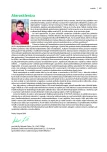Hypertension and hypercholesterolemia in the Czech population
Authors:
Peter Wohlfahrt 1,2,3; Alena Krajčoviechová 1; Jan Bruthans 1; Renata Cífková 1,2,4
Authors‘ workplace:
Centrum kardiovaskulární prevence 1. LF UK a Thomayerovy nemocnice, Praha
1; Mezinárodní centrum klinického výzkumu FN u sv. Anny v Brně
2; Laboratoř pro výzkum aterosklerózy, Centra experimentální medicíny IKEM, Praha
3; II. interní klinika – klinika kardiologie a angiologie 1. LF UK a VFN v Praze
4
Published in:
Vnitř Lék 2016; 62(11): 863-867
Category:
Original Contributions
Overview
Introduction:
Hypertension and hypercholesterolemia are inter-related ad mutually potentiating cardiovascular risk factors, which, when occurring together, strongly accelerate atherosclerosis and significantly increase cardiovascular risk.
The aim of our study was to assess the prevalence and control of both risk factors in the Czech population.
Methods:
A 1 % population random sample aged 40–64 years was examined within the Czech post-MONICA in 2006–2009. Hypertension was defined as systolic blood pressure ≥ 140 mm Hg and/or diastolic BP ≥ 90 mm Hg or use of antihypertensive medication. Hypercholesterolemia was defined according to cardiovascular risk and LDL-cholesterol levels or use of lipid-lowering drugs.
Results:
In a group of 2 508 persons (51 % of females), hypertension was found in 52 % and hypercholesterolemia in 40 % of examined individuals. Both risk factors occurred together in 30 % of subjects. While lipid-lowering drugs were used by 39 % of individuals with hypertension and hypercholesterolemia, target LDL-cholesterol were achieved by only 42 % of treated individuals. Only a total of 10 % individuals with both hypertension and hypercholesterolemia achieved target levels for both risk factors.
Conclusion:
Treatment and control of hypercholesterolemia in patients with hypertension remains unsatisfactory in the Czech Republic. Taking into account the high prevalence of hypercholesterolemia and the substantial increase in cardiovascular risk, lipid-lowering drugs should be considered in each patient with hypertension.
Key words:
antihypertensive drugs – Czech post-MONICA – lipid-lowering drugs – SCORE – target values – total cardiovascular risk
Sources
1. Lawes CM, Vander Hoorn S, Rodgers A et al. Global burden of blood-pressure-related disease, 2001. Lancet 2008; 371(9623): 1513–1518. Dostupné z DOI: <http://dx.doi.org/10.1016/S0140–6736(08)60655–8>.
2. Stamler J, Wentworth D, Neaton JD. Prevalence and prognostic significance of hypercholesterolemia in men with hypertension. Prospective data on the primary screenees of the Multiple Risk Factor Intervention Trial. Am J Med 1986; 80(2A): 33–39.
3. Cifkova R, Skodova Z, Bruthans J et al. Longitudinal trends in major cardiovascular risk factors in the Czech population between 1985 and 2007/8. Czech MONICA and Czech post-MONICA. Atherosclerosis 2010; 211(2): 676–681. Dostupné z DOI: <http://dx.doi.org/10.1016/j.atherosclerosis.2010.04.007>.
4. Cifkova R, Skodova Z, Bruthans J et al. Longitudinal trends in cardiovascular mortality and blood pressure levels, prevalence, awareness, treatment, and control of hypertension in the Czech population from 1985 to 2007/2008. J Hypertens 2010; 28(11): 2196–2203. Dostupné z DOI: <http://dx.doi.org/10.1097/HJH.0b013e32833d4451>.
5. Catapano AL, Reiner Z, De Backer G et al. ESC/EAS Guidelines for the management of dyslipidaemias: the Task Force for the management of dyslipidaemias of the European Society of Cardiology (ESC) and the European Atherosclerosis Society (EAS). Atherosclerosis 2011; 217: (Suppl 1): S1-S44. Dostupné z DOI: <http://dx.doi.org/10.1016/j.atherosclerosis.2011.06.012>. Erratum in Atherosclerosis 2011; 217(1): 2.
6. O’Meara JG, Kardia SL, Armon JJ et al. Ethnic and sex differences in the prevalence, treatment, and control of dyslipidemia among hypertensive adults in the GENOA study. Arch Intern Med 2004; 164)12 : 1313–1318.
7. Stern N, Grosskopf I, Shapira I et al. Risk factor clustering in hypertensive patients: impact of the reports of NCEP-II and second joint task force on coronary prevention on JNC-VI guidelines. J Intern Med 2000; 248(3): 203–210.
8. Halperin RO, Sesso HD, Ma J et al. Dyslipidemia and the risk of incident hypertension in men. Hypertension 2006; 47(1): 45–50.
9. Nickenig G. Should angiotensin II receptor blockers and statins be combined? Circulation 2004; 110(8): 1013–1020.
10. Sever PS, Dahlof B, Poulter NR et al. Prevention of coronary and stroke events with atorvastatin in hypertensive patients who have average or lower-than-average cholesterol concentrations, in the Anglo-Scandinavian Cardiac Outcomes Trial – Lipid Lowering Arm (ASCOT-LLA): a multicentre randomised controlled trial. Drugs 2004; 64(Suppl 2): 43–60.
11. Sever P, Dahlof B, Poulter N et al. Potential synergy between lipid-lowering and blood-pressure-lowering in the Anglo-Scandinavian Cardiac Outcomes Trial. Eur Heart J 2006; 27(24): 2982–2988. Erratum in Eur Heart J 2007; 28(1): 142.
12. Yusuf S, Bosch J, Dagenais G et al. Cholesterol Lowering in Intermediate-Risk Persons without Cardiovascular Disease. N Engl J Med 2016; 374(21): 2021–2031. Dostupné z DOI: <http://dx.doi.org/10.1056/NEJMoa1600176>.
13. Muntner P, Levitan EB, Brown TM et al. Trends in the prevalence, awareness, treatment and control of high low density lipoprotein-cholesterol among United States adults from 1999–2000 through 2009–2010. Am J Cardiol 2013; 112(5): 664–670. Dostupné z DOI: <http://dx.doi.org/10.1016/j.amjcard.2013.04.041>.
14. Matthews KA, Meilahn E, Kuller LH et al. Menopause and risk factors for coronary heart disease. N Engl J Med 1989; 321(10): 641–646.
Labels
Diabetology Endocrinology Internal medicineArticle was published in
Internal Medicine

2016 Issue 11
Most read in this issue
- A diet suitable for patients with dyslipidemia and metabolic syndrome
- Hyperlipoproteinemia in children
- Hyperlipoproteinemia and dyslipidemia as rare diseases. Diagnostics and treatment
- Uric acid as a risk factor for cardiovascular diseases
